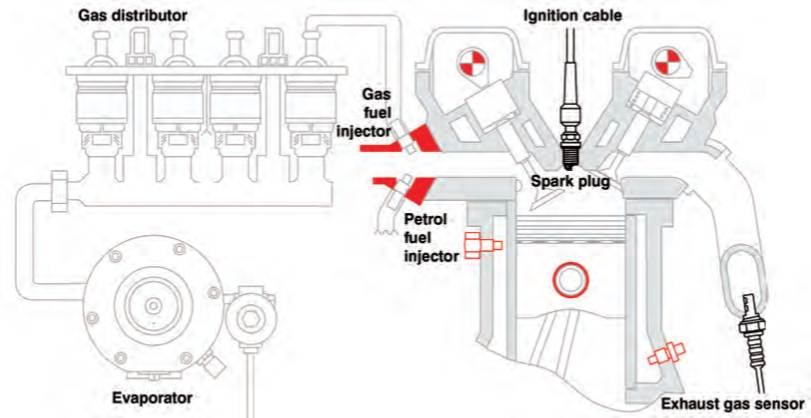Fuel Line

LPG Conversions & LPG Spark PlugsWith petrol and diesel prices soaring at the pumps more people could well consider looking into the benefits of running a car on liquefied petroleum gas (LPG) which is now up to 50% cheaper than petrol. In 2008, 17,000 LPG conversions were registered in the UK, bringing the total number of LPG vehicles on UK roads to approximately 160,000.* with the number of conversions increasing year on year, there is an opportunity for suppliers and garages to profit from this development. The vast majority of LPG vehicles are flex-fuel, operating on both LPG and petrol. Conversion specialists generally maintain that LPG reduces engine wear in spark-ignited engines. The rich fuel mixture required by petrol engines during cold starting and warm-up produces excess fuel which collects on the cylinder walls, stripping lubricating oil off the walls, thus contributing to accelerated wear of the engine. Gaseous fuels like LPG do not have an effect on the engine’s lubricating oils.
Fuelling layout of a typical gas converted engine system
Conversion of pre-1999 vehicles For vehicles built before 1999, the simplest type of LPG conversion is the Induction System. This system introduces vaporised gas to the engine through the inlet manifold. The ECU controls the flow of gas into the engine via an oxygen sensor in the exhaust line and a stepper motor to ensure optimum fuelling. Conversion of post-1999 vehicles For vehicles built after 1999, a different type of conversion, known as Multipoint Sequential Gas Injection Systems (SGIS) is used. SGIS injects vaporised fuel into each cylinder, close to the inlet valves. The system offers improved economy and performance (when compared with induction systems) and eliminates the possibility of spit-back.
The type and position of LPG components will differ from vehicle to vehicle; therefore a standard conversion as such does not exist. However there are a number of essential system components for those considering LPG conversion, including: LPG storage tank, vaporiser, regulator, mixer (supply ring), petrol delivery shut-off system, dash mounted ‘LED’ indicator and switch, and dedicated LPG spark plugs. An LPG fuel tank is made of sterner stuff than a petrol or diesel tank as it has to contain the fuel under pressure. Consequently it can survive a greater impact than a petrol or diesel fuel tank and contrary to popular belief is less likely to suffer crash damage. A number of vehicle manufacturers offer LPG options in the UK:
Recognising that the market lacked a range of spark plugs designed specifically for gas-powered engines, NGK developed a range of eight double-precious-metal-type spark plugs designed specifically for use in gas-powered engines, called LPG LaserLine. Running an LPG engine with ‘standard’ spark plugs can significantly reduce the service life of the plugs. However, by using NGK’s LPG specific plugs, not only are you likely to exceed the originally specified service life, but also avoid some of the misfire problems associated with LPG conversions. LPG LaserLine offers the Aftermarket a range of spark plugs that makes conversion and servicing easier and more reliable. Cutting-Edge Technology The combustion characteristics of gas are very different from that of petrol. A gas-air mixture is more difficult to ignite, therefore choosing a suitable plug is often difficult and time consuming. Required ignition voltage increases with gas, places significantly more stress on the ignition coils therefore increasing the risk of their failure. Also the temperatures at the plug are higher which means the ‘standard’ plug heat range may not be suitable. All LPG LaserLine spark plugs utilise NGK’s very latest technology. An iridium chip welded to the centre electrode allows its diameter to be reduced to just 0.6mm, considerably enhancing ignition performance. This enables the flame front to spread rapidly and evenly inside the combustion chamber, thus improving engine efficiency. Additionally, the slim electrode requires less ignition voltage. This is exceptionally important because gas is harder to ignite than petrol and ignition voltage requirement can rise by 7,000 volts. This fine electrode design therefore considerably reduces the risk of coil failure. The use of precious metals offers many benefits in gas operations including decreasing the risk of hot gas corrosion – which is much higher than with normal petrol operations as a result of the increased combustion temperatures. Additionally, the ignition performance of standard nickel spark plugs can deteriorate rapidly and will fall far short of the ‘normal’ service interval – an effect which will not occur using LPG LaserLine types. Apart from the electrodes, there are two additional features which make LPG LaserLine unique in the market. The electrode gap of all LPG LaserLine spark plugs has already been set to match operation on gas so workshop staff can simply install without the need for prior adjustment. In addition the metal shell of the plugs features a special chrome alloy coating which shields it from the aggressive and corrosion promoting conditions found in LPG engines. Although the NGK range of LaserLine LPG plugs has been available for some time, it is difficult to gauge the exact size of the overall UK market as most gas-powered cars are converted by specialists after initial registration. In spite of this, the LPG LaserLine range is said to include a perfect spark plug match for approximately 90% of all conversion-capable passenger cars in the UK.
|
Related Articles Related Downloads |

 LPG Specific Spark Plugs
LPG Specific Spark Plugs